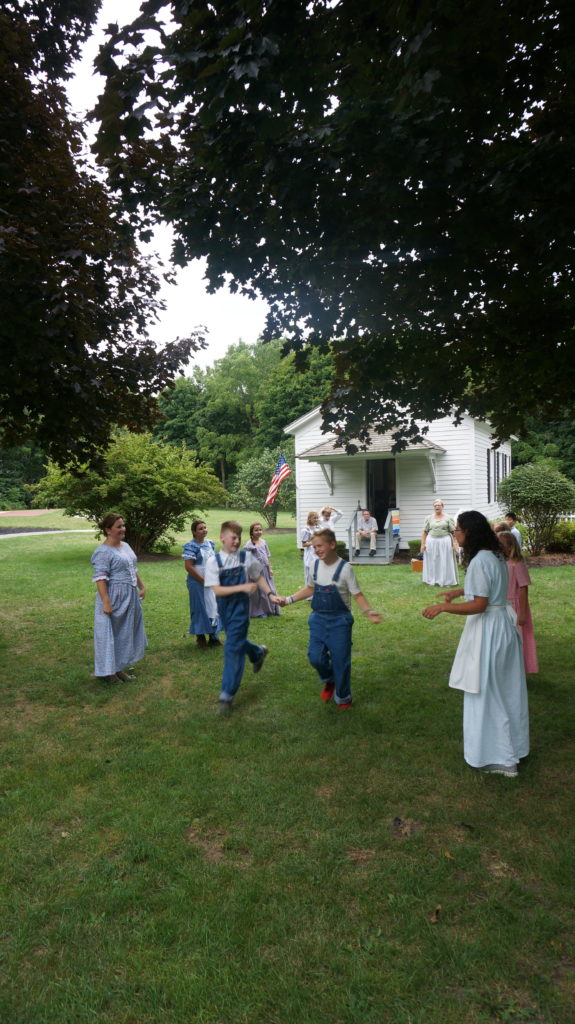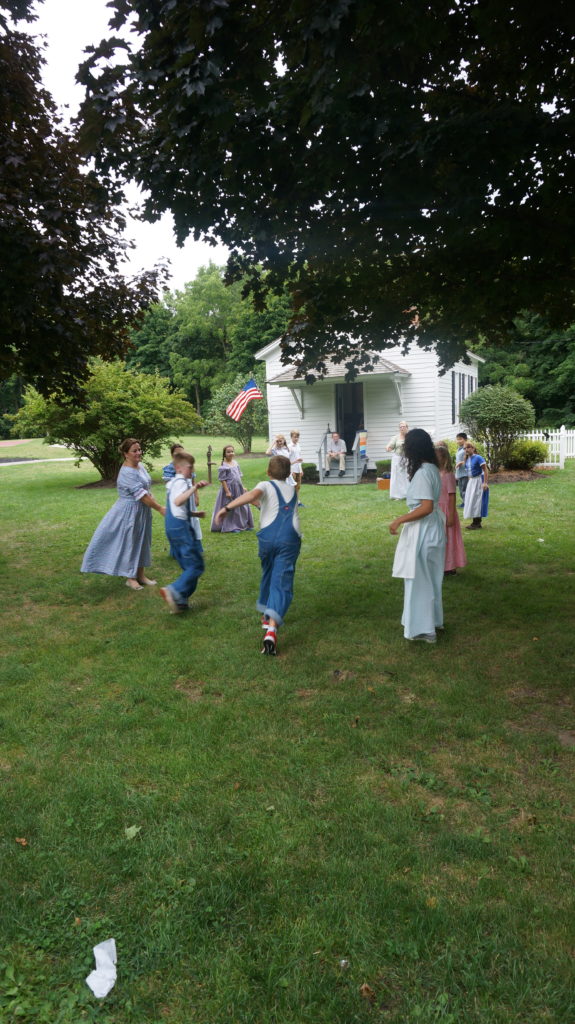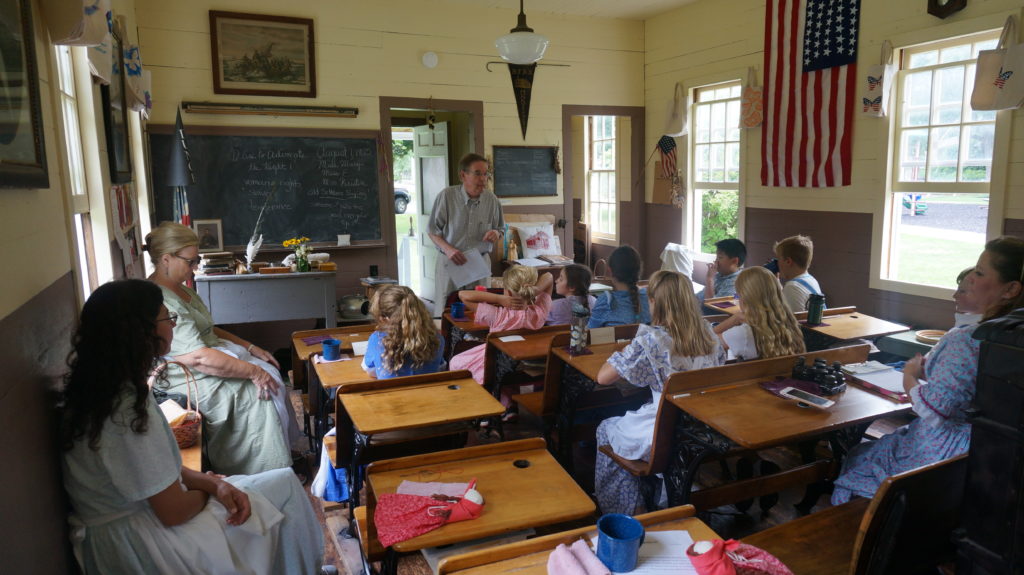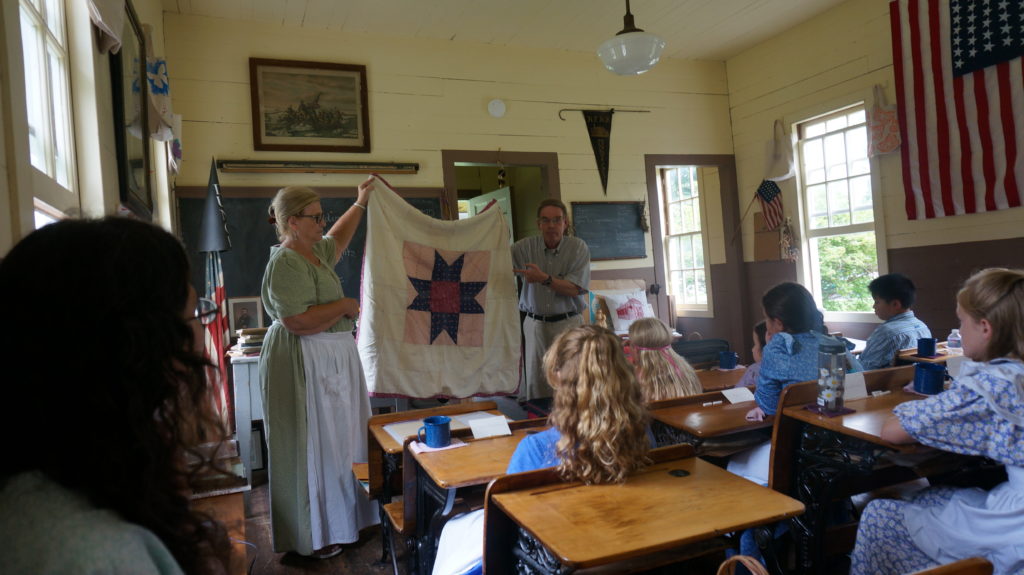Reels and history in Honeoye Falls
by D.E. Bentley –

 I can only guess that the Virginia Reel originated in Virginia. I did learn recently that it falls into the country-dance category. My reason for wondering about this early American dance was a recent encounter with some young dancers sharing their dance moves in front of the one room school house in Honeoye Falls. It was a warm and sunny summer day in Honeoye Falls, NY, on August 1, 2018, that I happed, while turning around, on a group of students reeling in the grassy lawn in front of the one-room schoolhouse. They were getting the hang of it, as pairs met up and moved through the lines of fellow dancers.
I can only guess that the Virginia Reel originated in Virginia. I did learn recently that it falls into the country-dance category. My reason for wondering about this early American dance was a recent encounter with some young dancers sharing their dance moves in front of the one room school house in Honeoye Falls. It was a warm and sunny summer day in Honeoye Falls, NY, on August 1, 2018, that I happed, while turning around, on a group of students reeling in the grassy lawn in front of the one-room schoolhouse. They were getting the hang of it, as pairs met up and moved through the lines of fellow dancers.
The school – Mendon District School Number 15 – was moved to the Village of Honeoye Falls and in 1991 and opened to the public as part of a Village Days celebration. The Honeoye Falls/Town of Mendon Historical Society has transformed the building into a living history museum. During the 19th and early 20th century, the rural school often also served as a church, meeting place, and theater, thereby bringing the community together.
The students I encountered at the schoolhouse were part of Miss Eliza’s Summer Session. “Miss Eliza,” Jennine Milne, started the program in 1994! The summer program features a weeklong day school for children ages 9-11 who have completed the local history study in school. Children learn about the schools, homes and life of the 19th century by role playing, dancing, listening to stories and presentations and making crafts. A simple graduation social is held on the Friday afternoon of the camp. It takes place at the one room schoolhouse in Harry Allen Park, in the village of Honeoye Falls and is sponsored by the Honeoye Falls-Town of Mendon Historical Society.
As the dance, and recess, ended and rain began to fall, the students moved inside in period dress and settled into their seats. On the day I happened by there was a presenter. Mr. Bennett, and the lesson was on the Underground Railroad – a relevant part of our historic past and present, 400 years in the making. Starting in the late 1700s, Mr. Bennett shared, a network of abolitionists began offering shelter and aid to enslave people as they made their way north to freedom. The presentation, unlike writing, reading and math lessons offered to explore how students were taught in the 19th century, was a contemporary lesson, reflecting on the lessons we have learned, hopefully, from our mistakes of the past. The students listened attentively and asked questions as the teacher talked of the first slave who, in 1619, set foot in the Americas. He talked of the slave triangle and the treatment of humans like property. He shared a “For Sale” sign, from The Old Slave Mart on Chalmers Street in Charleston, South Carolina. “Kids were worth zero.” They could not work,” he added, when a student asked the reason why children were “free.” He talked of the impact of years of slave trade on the enslaved and on the enslavers. Have you heard the song “Amazing Grace?” he asked the assembled students, who sat attentively in their chairs. It was written by a Captain John Newton who wrote it after he, “met God on the high seas and went back to England to become a priest.” After being a slave shop captain, he became an abolitionist.
 The lesson touched on Frederick Douglass’ life and accomplishments. Named Fred Bailey after the owner of the plantation where he was taken, Douglass learned to read, helped by Bailey’s wife. Douglass was “rented out” as a caulker in the shop yard and met free black men at the docks. He ran away and was sheltered in the home of a Mr. Johnson who, wanting to give him a new name to travel by, saw the name “Douglas” in a poem called Lady of the Lake written by Sir Walter Scott and published in 1810. Fred Bailey became Frederick Douglass.
The lesson touched on Frederick Douglass’ life and accomplishments. Named Fred Bailey after the owner of the plantation where he was taken, Douglass learned to read, helped by Bailey’s wife. Douglass was “rented out” as a caulker in the shop yard and met free black men at the docks. He ran away and was sheltered in the home of a Mr. Johnson who, wanting to give him a new name to travel by, saw the name “Douglas” in a poem called Lady of the Lake written by Sir Walter Scott and published in 1810. Fred Bailey became Frederick Douglass. 
Johnson’s home was part of the Underground Railroad, a place where people could hide until they moved on, closer tofreedom. Abolitionists continued the fight against slavery and one newspaper, The Liberator published by William Lloyd Garrison, and many other leaders for the cause, were relentless in their fight. In December 1847, Mr. Bennett continued, Frederick Douglass began publication of his newspaper, called The North Star. The newspaper’s title referenced the direction of freedom; the star was used as a point of reference to guide people north toward Canada. The North Star is also a traditional quilt pattern. Mr. Bennett’s daughter illustrated a children’s book on the topic called The Patchwork Path: A Quilt Map to Freedom (August 28, 2007 by Bettye Stroud, Author and Erin Susanne Bennett, Illustrator), a fictionalized account of a family that used patterns sewn into a quilt to find their way to Canada and freedom. There are other references to the journey north in stories and in song. The North Star is in the constellation of the Big Dipper, which resembles a drinking gourd. Follow the Drinking Gourd is a well-known folk song. A Pete Seeger version was played during the lesson.
As with other on-room school houses that have been preserved as living history museums, this experience allows students to have fun role-playing while also learning first hand about the experiences of young people of the past. These lessons include the leisure activities, such as dance, music and games that occupied their free time. They also allow students to learn about the hardships and realities of life long ago for many different groups of people and gave them the opportunity to relate history to the present; to reflect on the world of today by learning about the lives of young people who lived in the area long ago.